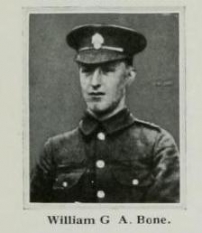| First Name: | William George Alfred | Last Name: | BONE | |
|---|---|---|---|---|
| Date of Death: | 27/04/1915 | Lived/Born In: | Finsbury | |
| Rank: | Private | Unit: | London4 | |
| Memorial Site: | Menin Gate, Ypres | |||
Current Information:Born-St Lukes Battle of St Julien, 24 April – 4 May 1915 Spurred on by the success of their gas attack on 22nd April, the Germans struck again two days later on the northern sector of the Ypres salient at St. Julien. Once more chlorine gas was used and despite a resolute defence the British and Canadians were pushed back and St Julien was lost. For nearly 2 weeks the fighting continued on this front. The Germans persisted with their attacks, the British fought desperate rear guard actions and launched many counter attacks but gradually they were pushed further and further back. Eventually, during the night of 3rd & 4th May the British forces were withdrawn from their forward positions and took up a new defensive line closer to Ypres. On 26 April, 1915 the Lahore Division of the Indian Corps were ordered to move from Ouderdom, behind Ypres to the Wieltje-St Jean area in the salient where the Germans had launched their gas attack and then, at 2pm, to attack northwards on a 1000 yard front against Langemarck, through the sector, east of the Ypres-Langemarck road, held by 13 Brigade. 1st Manchester of Jullunder Brigade and Connaught Rangers from Ferozepore Brigade led the attack, with 4th London, Ferozepore Brigade, following later in the day. The advance moved up the gentle rise to Hill Top Ridge then across a shallow valley. Beyond them was the German line on the slopes of Mauser Ridge. They were heavily shelled on top of Hill Top Ridge where large 5.9 Howitzer shells knocked out whole platoons at a time. Nevertheless the two leading battalions advanced through 13 Brigade’s line but heavy machine gun fire from the head of the valley, north-east of Canadian farm, drove the whole movement to the left. At 2.20pm, as the leading British troops reached the German wire, the Germans released gas on their right which drifted from west to east across their front. At the same time the Germans redoubled their fire and the attack faltered and came to a stop. It was at this stage that 4th London began their advance. Cresting the rise they witnessed some troops streaming back, panicked by gas but, ordered to follow Connaught Rangers at all costs, 4th London kept their formation and moved on to the Buffs Road despite the attention of the German artillery. They joined the remnants of 2nd Scottish Borderers here (less than 100) and the reserve company of Connaught Rangers but were unable to make any further progress. At 6pm German shelling of Buffs Road caused many more casualties among 4th London. But worse was to come. On the next day, 27th April, after a period of intense German shelling of their positions, 4th London in conjunction with other units from the Lahore Division and some French Troops led an attack against Oblong Farm, a moated farm house about a mile away. It turned out to be another tragic episode in the confused and fierce struggle to the north-east of Ypres in April 1915. No time to prepare the attack and limited artillery support combined with murderous German fire, especially when crossing the crest of the hill at Admirals Road, brought the attack to a standstill with very many either killed or wounded. Later in the day, violent German shell fire drove all the attacking troops back to their starting line. |
||||
Other Photos: |
||||
| « Back to Search Results | ||||
| If you think any of the information shown here is incorrect, Click Here to submit your amends and comments | ||||





